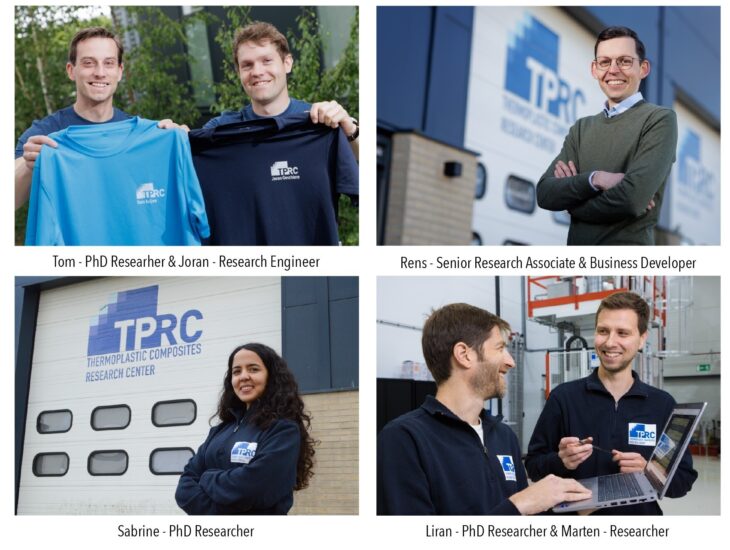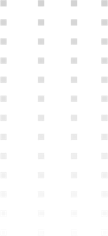#TPRCminds | Marten & Liran
Researchers
‘Chemistry minds at TPRC’
Researchers Liran Katz and Marten van der Werff are the odd ones out in the engineering team at the TPRC. With their backgrounds in chemistry, they complement the skills of their colleagues, who mostly have been trained as mechanical engineers.
Read other #TPRCminds interviews with Jeroen (Research Engineer), Yannick (PhD Researcher), Jagadeesh (PhD Researcher), Vanessa (PhD Researcher), Erik (Researcher, Business Developer) and Edwar & Martin (Research Technicians).

Liran focuses on the hybrid joining of thermoplastic and thermoset composite materials. Marten is mainly involved in research on surface treatment of thermoplastic composites for painting and other applications. Marten has been with TPRC for over seven years, while PhD researcher Liran just completed his first year at the research center. Here are their experiences so far.
To broaden the application of thermoplastic composites in the aviation industry, we must find a way to bond new materials to large thermoset structures without using nuts and bolts or other fasteners, including adhesive-based solutions. According to Liran and Marten, the key is seamlessly joining the materials without any material strength loss. In addition, thermoplastics are also used in non-structural elements, such as the outer skins of airplane wings. The application of protective coatings involved in this process is also an example of bonding between dissimilar materials.
Israel
Liran’s affinity for the field can be traced back to his education in his native Israel. Since his bachelor studies in the department of chemical engineering at The Technion – Israel Institute of Technology, the oldest university in Israel, Liran was always drawn to the materials world. In his masters work he came across the composites world and fell in love with it. Liran: “The ability to combine the advantages of two different materials into one enhanced entity was and still is a fascinating concept. After spending a decade in the composites industry, I felt I needed a change in order for me to continue with the same passion I had when I started. Although my last position was R&D team leader in an innovative composites department, I felt there was more of the ‘D’ than the ‘R’. So, when I discovered that my company provides an overseas PhD program for designated employees, I knew this was the path I wanted to pursue.”
Adventure
Liran’s lust for adventure eventually led him and his family to Enschede and to TPRC. “Everything fell into place: a great country with great people on one hand, an innovative research center that deals with cutting edge research for industrial partners on the other hand. TPRC is the place to be for making your composite dreams come true.”
Liran, who describes himself as a ‘non-standard PhD candidate at a Dutch university’ because of his age, spent the first year of his PhD on a literature review. He found out that there is still a lot of territory left to explore when it comes to the hybrid joining of thermoplastic and thermoset composite materials. Liran: “A wider understanding of this technique, both in physics and chemistry, is crucial for the broader application of thermoplastic composites. After my literature review, it was time to get hands-on, so I started experimenting with the different hybrid joining and surface treatment techniques.”
With TPRC from the very beginning
For his lab experiments, Liran often works together with a colleague who has quite some years at TPRC under his belt: Marten van der Werff. Contrary to his Israeli colleague, Marten stayed very close to home. In fact, he’s pretty much the only person from Enschede in the entire TPRC team. Surface treatment is where Liran and Marten find each other. The million-dollar question is: What’s the best way of joining thermoplastics and thermosets? “An added challenge is that we prefer not to involve other materials, such as adhesive.” Marten explains. “Broadly speaking, there are three options. Mechanical treatment, such as sanding or sandblasting, energetic-based methods, such as plasma or UV treatment, and the chemical approach. The latter involves modifying the molecular structure of the materials in such a way that they stick together. This is still very much a black box and that’s why we are so fascinated by it.”
Lots of expertise
Just before this interview, Marten was reminded of having been with TPRC pretty much from the word go. “I got a notification saying that my colleague Jeroen Houwers has been my LinkedIn connection for seven years,” he says and winks. “After studying Chemistry in Groningen and completing a master’s degree in Berlin, I started at TPRC as an intern. I liked polymer science and was able to use my chemical background, albeit in an entirely new field. I look at materials at the molecular scale, at their chemical interactions and their structure property relations. Throughout the years I have acquainted myself with mechanical and technical side of composites. If this isolates me from them? Not at all, we really complement one another.”
When he started out at TPRC, Marten got a lot of questions. “Small and big questions on such matters as the thermal stability and degradation of materials. Not a lot was known about those things yet, which immediately made me feel like I had something to contribute here as a chemistry expert. This was confirmed in my first Technical Advisory Board (TAB) meeting with our partners. They were also fascinated with my view of things and that served as a great motivation. It still does, actually. Recently the topic of surface treatment of thermoplastic composites prior to painting has gained a lot of interest since they are more widely applied. The challenge is that thermoplastic composites have a high chemical resistance and are therefore very difficult to bond to other materials. Sandblasting, which increases the surface roughness, is one method that has already been industrialized, but it’s not ideal since the surface chemistry is not affected by it. Finding a surface treatment solution that is able to chemically activate the surface in an efficient way and which subsequently enables the formation of a strong and durable bond, that’s the holy grail.”
Close-knit team
Whereas Marten was very familiar with his surroundings and TPRC, this wasn’t the case for Liran. Marten: “Our team is a lot bigger now, but the atmosphere is still very open. At TPRC we have a lot of freedom to carry out our work as we see fit and to touch base with colleagues and industry.” Liran: “That is definitely true. Although everything was new, I felt part of the team from the beginning. There’s a great, scholarly vibe here. Everyone wants to help each other.”
Although Liran is an adventurer with great adaptation skills, he recognizes the first months in Enschede weren’t always easy. “We live close to the center of Enschede and generally enjoy the cozy and quiet atmosphere, but sometimes our Israeli DNA gets in the way a little bit. We moved here from Haifa, where life was warm and intense. We sometimes miss the beach and the views of Mount Carmel, which was very close. For the rest we are doing great. Our kids are going to the international school in Enschede and like it there. Their English is getting quite good. As a PhD candidate, I have a few more years to go here and I’m looking forward to it – I’m looking forward to the future.”
Our series #TPRCminds introduces you to the people behind our success. Who are they? What is their background? What drives them and what do they dream about? How do they look at the future of thermoplastic composites? Continue reading other #TPRCminds episodes:
Photos ©Gijs van Ouwerkerk




